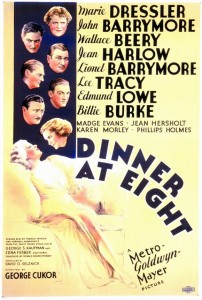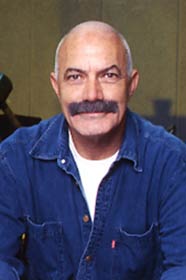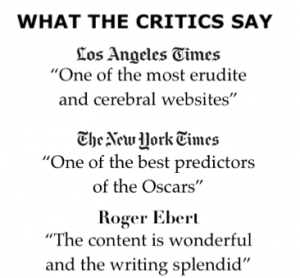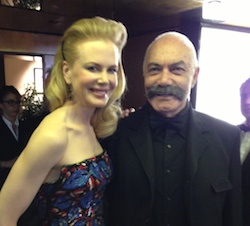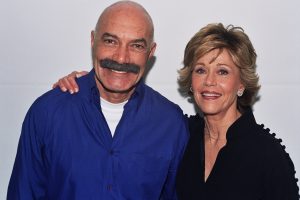Like Grand Hotel, MGM’s 1932 Oscar-winning picture, George Cukor’s 1933 comedy, Dinner at Eight, is a multi-character film, made in the Thalberg tradition of literary quality and high-caliber ensemble of stars (all largely playing supporting roles).
David O. Selznick moved to MGM in February 1933 to head up one of its production units. It was not very difficult for him to persuade Cukor to once again follow him. Ruled with a firm hand by Louis B. Mayer, MGM was then the most prestigious studio in Hollywood.
| Dinner at Eight | |
|---|---|

Theatrical release poster
|
|
The adaptation of Dinner at Eight was co-penned by Frances Marion, Herman Mankiewicz, and Donald Ogden Stewart, based on George S. Kaufman and Edna Ferber’s popular Broadway play. This was the first MGM film made by George Cukor, and its splashy performance at the box-office immediately positioned him as the studio’s top director.
For Cukor, Kaufman was not a particularly profound writer, but he could write funny dialogue, which the adapters used as a blueprint, while adding their own witticisms.
Like Bill of Divorcement, Dinner at Eight was a straightforward, unobtrusive adaptation of a stage work with little attempt to go beyond a proscenium perspective; neither film contained exterior shots.
Unlike Bill of Divorcement, however, Dinner at Eight still maintains its contemporary edge. For audiences in 1933, the film’s ambience was very timely. with the underlying sense of Depression behind the comedy, and a sense of anxiety below the surface. The characters are bitter or insecure: Husbands cheat on wives, the rich are scared of going broke, actors lose their looks–and jobs.
The story revolves around a dinner party given by Millicent Jordan (Billie Burke), a foolish snob obsessed with status. As her guests arrive for a dinner party, in honor of VIP’s (who never show up), the carefully planned evening falls apart. Her husband, Oliver Jordan (Lionel Barrymore), seriously ill and in danger of loosing his business, invites crass industrialist Dan Packard (Wallace Beery) and his vulgar wife Kitty (Jean Harlow) in an attempt to salvage their fortunes. Their daughter Paula (Madge Evans) falls in love with Larry Renault (John Barrymore), a pathetically fading matinee idol, and abandons her fiance.
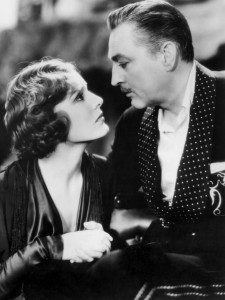 The script was written in four weeks by Herman Mankiewicz and Frances Marion, but Selznick brought in Donald Ogden Stewart, who had scripted Tarnished Lady, to make additional contributions. Stewart wrote the classic exchange between Kitty and aging Charlotta (Marie Dressler). Harlow says: “I was reading a book the other day, machinery is going to take the place of every profession.” With a pointed glance at her sexy rear, Dressler retorts, “Oh, something you need never worry about, my dear.” Dressler’s quip became one of the most memorable lines in movie lore.
The script was written in four weeks by Herman Mankiewicz and Frances Marion, but Selznick brought in Donald Ogden Stewart, who had scripted Tarnished Lady, to make additional contributions. Stewart wrote the classic exchange between Kitty and aging Charlotta (Marie Dressler). Harlow says: “I was reading a book the other day, machinery is going to take the place of every profession.” With a pointed glance at her sexy rear, Dressler retorts, “Oh, something you need never worry about, my dear.” Dressler’s quip became one of the most memorable lines in movie lore.
Preserving the play’s caustic humor, the script softened some of its elements. Goaded by Kitty, for example, Packard decides against wresting control of Jordan’s shipping company. And when Paula learns about Renault’s death, she returns to her fiance, who knows nothing of the affair. These concessions were made to accommodate the audience’s taste at the time.
But some people were still troubled by the film’s ruthless cynicism–which is precisely what attracted Cukor to the material. People’s deceits and self-deceptions, their double and triple natures, are the film’s thematic core. “You’re two people really. One’s magnificent and the other’s very shady,” says a long-suffering wife to her philandering husband. These motifs, deception and self-delusion, would become prevalent in Cukor’s work.
Budgeted at $420,000, Dinner at Eight was made in the Thalberg tradition of literary quality, a modern drama with meaningful text. Because MGM had just released Grand Hotel, which won the 1932 Best Picture Oscar, invidious comparisons between the two movies were inevitable. Like Grand Hotel, Dinner at Eight was a multi-character contemporary, and like the 1932 film, it cashed in on MGM’s great gallery of stars.
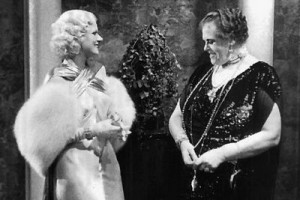 Unlike the troubled and bumpy production of Grand Hotel, Dinner at Eight got off to a smooth start on March 16, 1933. Cukor was able to complete shooting in four weeks. “That was a wonderful record,” Cukor said, “I owed it all to these marvelous performers; with them behind me, everything seemed possible.” The fact that the film contains no sustained scenes undoubtedly contributed to Cukor’s ability to make it quickly.
Unlike the troubled and bumpy production of Grand Hotel, Dinner at Eight got off to a smooth start on March 16, 1933. Cukor was able to complete shooting in four weeks. “That was a wonderful record,” Cukor said, “I owed it all to these marvelous performers; with them behind me, everything seemed possible.” The fact that the film contains no sustained scenes undoubtedly contributed to Cukor’s ability to make it quickly.
Initially, Louis B. Mayer did not want to cast Jean Harlow as the flashy wisecracking blonde. Unconvinced of her talent, he feared she might suffer in comparison to Dressler, who played Carlotta, the aging grande dame–but Cukor fought for Harlow and won. Admittedly, Harlow had given weak, self-conscious performances in The Public Enemy, but in Red Dust Cukor noted her natural talent for comedy.
Harlow was a wise-cracker who conveyed at once toughness and vulnerability–a combination of qualities that made her attractive to both male and female viewers. Harlow had an uncanny knack for delivering her lines as if she had no idea of what she was saying. During the shoot, Cukor got to know Harlow well, finding her subtler and shrewder than given credit. “She was a real actress,” he later said, “with beautiful manners, a rather lady-like creature.” He was thus irritated by the lurid stories that circulated about her.
Cukor brought out the best in Harlow in his acute direction of her big scene where she tells off Wallace Beery. Beery finds her lying in bed wearing a new black hat in an all-white bedroom. She sits up, pushes back her hat (as if she was sitting on the toilet, Cukor put it) and without pulling any punches yells, “You big windbag!” When Beery plays the bigshot and has to go to Washington, she looks at him, clearly bored but still impressed, and says, “Yeah, you better go and fix things.” Cukor would orchestrate a similarly effective scene with Judy Holliday in Born Yesterday.
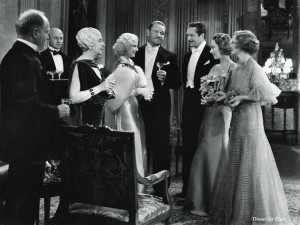 Barrymore’s superb portrayal of the tragic Renault was done as black comedy. Playing a second-rate actor–which, of course, he was not–Barrymore’s subtlety and wit turned Renault into an ignorant ham. An expert at shading his performance, Barrymore’s ability to immerse himself into a character and let that character transcend his own personality was remarkable. In his first shot, Barrymore is on the telephone trying to impress a society woman; his speech is well-observed and accurate. But when he turns to ask for a drink from the bellhop, his fake grandeur instantly disappears.
Barrymore’s superb portrayal of the tragic Renault was done as black comedy. Playing a second-rate actor–which, of course, he was not–Barrymore’s subtlety and wit turned Renault into an ignorant ham. An expert at shading his performance, Barrymore’s ability to immerse himself into a character and let that character transcend his own personality was remarkable. In his first shot, Barrymore is on the telephone trying to impress a society woman; his speech is well-observed and accurate. But when he turns to ask for a drink from the bellhop, his fake grandeur instantly disappears.
Cukor was particularly fond of a scene where Renault learns he has lost the job he desperately needs, because he is not British. “I can be English.” he says. “I can be as English as ahnnybohdy.” “Oh, that is wonderful, Jack!” Cukor enthusiastically said whenever the actor surprised him. “Well, it ought to be,” Barrymore retorted, “This is a combination of Maurice Costello (his father-in-law), Lowell Sherman (his brother-in-law), and me.”
Under Cukor’s direction, Barrymore was most effective in his death scene, one of the screen’s most vivid and pathetic suicides. Cukor suggested that Renault, always the actor, would die in a picturesque way but that he should botch his suicide–like everything else in his life. As shot, Barrymore, again drawing heavily on Lowell Sherman and Maurice Costello, walks very grandly across the room, then trips over a stool, gets up, pulls himself together, sits down in a chair and turns his profile to the light–in a suitable death pose. This marvelous scene taught Cukor that “If first-rate actors respect you, they’ll try anything you suggest.”
As a whole, the casting of the film could not have been better. Marie Dressler was outstanding as the gaudy, comical dowager. The biggest star of her time, Dressler’s specialty was low comedy–she would mug and carry on, but she knew how to play an actress with great aplomb. Homely, Dressler herself found it incredible she was playing an ex-beauty with a host of suitors. To make Carlotta more believable, Cukor proposed a campy, tongue-in-cheek approach.
Cukor’s only regret was his “great disservice” to Billie Burke, casting her as the feather-brained “flibbertigibbet.” Burke was so convincing that she was typecast in similar roles for the rest of her career. But Cukor knew that Burke “forgave” him; it was not in her character to hold grudges.
The film’s cast did not escape the biting humor of screenwriter Herman Mankiewicz, commenting on Cukor’s ability to coax great performances from his stars. “It must be awful tough for you to show Marie Dressler how to perform an old actress who’s very ill,” he quipped, “and I can see the difficulty in making Lionel Barrymore understand the emotions of a man who has an extravagant wife, or Jack Barrymore comprehending the feelings of a fading matinee idol.” Mankiewicz also “sympathized” with Cukor for trying to make a sexy tart out of Jean Harlow, and uncouth creature out of Wallace Beery. Indeed, details of Barrymore’s biography–Renault talks about his profile and drinking–were used to enhance his part. This interplay between the actors’ offstage and onstage personalities enriched the plot and its meanings.
In Dinner at Eight, considered the best film made from a Kaufman play, Cukor achieved a fine balance of comic and serious tonalities, a blend of high comedy and melodramatic pathos that would become one of his specialties. He also managed to fuse a broad range of acting styles (Harlow’s natural charm, Beery’s mugging, Dressler’s grand delivery) into a coherent ensemble piece. Yet, each star enjoyed one special vignette that lingered in memory-a tribute to Cukor’s directorial skills.
Having directed half a dozen films, Cukor felt he had begun to know his way around the camera. Dinner at Eight marked a significant change in Cukor as a director. Here, Cukor showed deeper understanding of the kind of performances that worked in movies–the difference between stage and screen acting.
Production commenced on March 16, 1933 for a film that was allocated only 27 days of shooting. “That was a wonderful record,” Cukor later recalled, “I owed it all to these marvelous performers, with them behind me, everything seemed possible.”
Spoiler Alert: The Last Scene
The comedy ends on a memorable scene and high tone. As the guests slowly walk into the dining room, Kitty tells Carlotta, “I was reading a book the other day,” which give Carlotta pause and double take: “Reading a book?” she says? “Yes, it’s all about civilization or something. A nutty kind of a book. Do you know that the guy says that machinery is going to take the place of every profession?” Carlotta then looks her up and down, and says “Oh, my dear, that’s something you need never worry about.”
Cast
Marie Dressler as Carlotta Vance
Lionel Barrymore as Oliver Jordan
Billie Burke as Millicent Jordan
madge Evans as Paula Jordan, the Jordans’ rebellious daughter
Wallace Beery as Dan Packard, a successful if crooked businessman
Jean Harlow as Kitty Packard, a lonely, conceited woman and wife of Dan Packard
John Barrymore as Larry Renault
Lee Tracy as Max Kane, Larry Renault’s desperate agent
Edmund Lowe as Dr. Wayne Talbot
Karen Morley as Lucy Talbot, Wayne Talbot’s longsuffering wife
Jean Hersholt as Jo Stengel, a theatrical agent
Phillips Holms as Ernest DeGraff, fiancé of Paula Jordan
Cameos
Edwain Maxwell as Mr. Fitch, the hotel manager
Louise Closser Hale, as Hattie Loomis, a dinner guest
Grant Mitchell, as Ed Loomis, a dinner guest
Credits:
Directed by George Cukor
Produced by David O. Selznick
Screenplay by Frances Marion, Herman J. Mankiewicz, additional dialogue by Donald Ogden Stewart, based on Dinner at Eight, the 1932 play by George S. Kaufman and
Edna Ferber
Music by William Axt
Cinematography William H. Daniels
Edited by Ben Lewis
Distributed by Metro-Goldwyn-Mayer
Release date: August 29, 1933
Running time: 113 minutes
Budget $435,000
Box office $2,156,000
